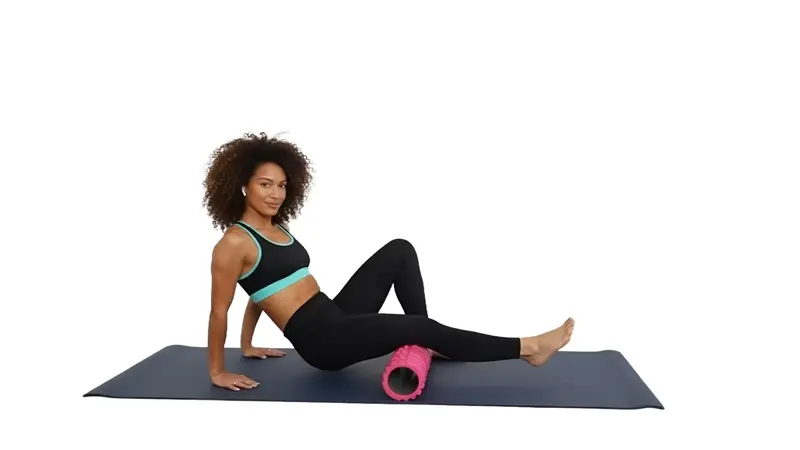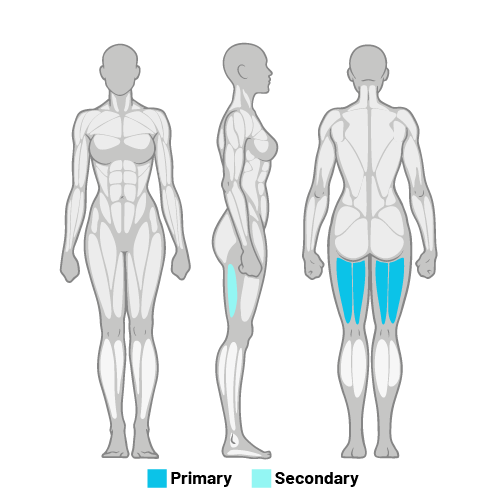Tight hamstrings from running, sports, or sitting can strain hips and back. The foam roller hamstring exercise relieves tension, boosts circulation, and restores mobility to keep your legs moving well.
How To Do the Foam Roller Hamstring Exercise

- Sit on the floor with your legs extended and a foam roller under your hamstrings.
- Place your hands on the floor behind you for support.
- Lift your hips slightly and slowly roll from just above the knees to just below the glutes.
- Pause on any tender spots, holding gentle pressure for 20–30 seconds.
- Repeat as needed, then switch sides if rolling one leg at a time.
Muscles Worked
The hamstrings are a group of three muscles that bend the knee and extend the hip. They attach at the ischial tuberosity—the sit bones—and play a critical role in stride mechanics for sports and daily activity.
Muscles involved:
- Biceps femoris
- Semitendinosus
- Semimembranosus
Foam rolling also influences nearby tissues such as the glute muscles and the IT band, both of which often tighten with running, soccer, or long hours of sitting. By addressing these tissues, foam rolling helps protect the hips, sacrum, and lower back.
Why Foam Roll the Hamstrings?
Foam rolling is not just a feel-good routine—it’s a tool for recovery, mobility, and injury prevention. By improving circulation and easing tension, it helps muscles recover faster and stay resilient. Looser hamstrings also support smoother running mechanics, stronger yoga poses, and more efficient sports performance.
Key benefits include:
- Faster muscle recovery after exercise
- Improved range of motion
- Reduced risk of strains or pulls
- Relief from stiffness caused by sitting or overuse
Form and Technique Tips
The biggest mistake with foam rolling is moving too quickly. Slow, steady pressure is what allows tissues to release. Keep your core engaged, shoulders relaxed, and breathe deeply throughout.
Tips to remember:
- Don’t roll directly on the back of the knees—focus on the muscle belly.
- Don’t skip sore areas; pause briefly to let them release.
- A slight bend in the knee changes the angle and targets deeper fibers.
- For more intensity, stack one leg on top of the other. For less, keep both legs on the roller.
How Long, How Often, and When To Roll
You don’t need endless rolling—just consistency. Spend about 30–60 seconds per hamstring, two to four times per week. Athletes in heavy training cycles may roll more often, but it’s better to focus on quality rather than quantity.
When to roll:
- Before workouts: Short, light rolls to prime mobility.
- After workouts: Deeper rolling to ease soreness and support recovery.
- On rest days: Gentle rolling to prevent stiffness from sitting.
Who Should Be Cautious
Avoid foam rolling if you have a recent hamstring tear, severe varicose veins, or sacrum/lower back pain that worsens with pressure. Those in rehab should check with a sports medicine doctor or physical therapist before adding rolling to their routine.
Keep Your Stride Strong With Sporty Doctor
Foam rolling your hamstrings is one of the simplest ways to keep your legs healthy, your hips mobile, and your back protected. It won’t replace stretching—one controlled trial found that structured stretching created greater flexibility gains than foam rolling—but as part of a well-rounded routine, it’s a proven tool to recover smarter and move better.
Your body is built to move—so let’s keep it that way. Download the Sporty Doctor App for physician-designed routines that combine stretching, mobility, and recovery into one easy-to-follow program.














